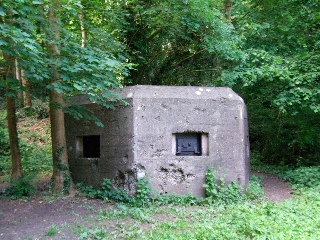The Netherlands remained neutral during the Great War. Although some parts of the Defence Line were finished by this time, the construction was completed in 1920. The Defence Line was already in use by then and during the mobilisation, soldiers were actually stationed at the forts. There were no inundations set in this period.
|
| Picture of the defence forces at Fort near Nigtevecht of the 1914-1919 mobilisation. (Picture: Collection Army Museum, Delft, The Netherlands / Jaap de Zee, 1916) |
Although German spies in 1903 were impressed by the Defence Line (despite bad organisation and reinforcements), is it unclear whether the Netherlands neutrality was actually due to the Defence Line and the other water defence lines.
The former military attaché Charles à Court wrote to the British Chief of Staff fieldmarshall W. Robertson in 1917: "... keep out of Low Country Fighting. (...) You can fight in mountains and deserts, but no one can fight in mud and when the water is let out against you, at the best, you are restricted to the narrow fronts on the higher ground, which are very unfavourable with modern weapons."
On the 31st of July 1914, total mobilisation of troops was declared and the conscripts arrived at the forts of the Defence Line. By the 2nd of August, all the forces were stationed at the forts and several days later, the defence occupation of 10,000 soldiers was ready to fight. The actual Defence Line infantry, would comprise forces from the peripheral provinces and of retreated forces. After four years of troop mobilisation, the soldiers had had enough of the bad food, the dark and humid accommodation, the poor clothing. In brief, they had enough of life as soldiers. In some places riots had even broken out.
Two years after 1918, when it was declared that there would never again be war in Europe, the Defence Line was ready. On top of this, long distance artillery and warplanes came into service, forecasting the end of, or at least posing a large threat to, the requirement of a permanent defence line which relied on a water barrier to keep the enemy at a distance.
 |
| A casemate of the Grebbe-line near Rhenen. (Picture: René Ros, 2007) |
During the Second World War, on the 10th of May 1940, the German army invaded The Netherlands without warning. Dutch capitulation was already declared before the Germans had even reached the Defence Line. However, inundations were made north of the North Sea Canal to defend the north side of the "Fortress Holland". But the Blitzkrieg and the use of aeroplanes with paratroopers proved too quick for the Dutch army, which was largely untrained and old-fashioned, because of the Dutch economy at the time. But the many German attempts to break the Grebbe-line proved how a small army could resist an large enemy with prepared strongholds.
The capitulation came as a surprise to the German commanders, even though Dutch surrender had been requested. Some German commanders expected a though job still lay ahead: the New Dutch Waterline.
During the Second World War, most of the forts were used as barrack by the Germans. The Germans removed a lot of metal from the forts for their own use. Because they supplied the guns and turrets (mostly Krupp-Gruson), they knew how to get the highest quality of steel back to recycle it for use in their own war-effort.
At the end of the war, the Germans used the typical Dutch defence against Dutch liberators; the southern part of the Defence Line was prepared as stronghold and they raised two large water defence lines to stop a successful allied landing on the coast. The two water defence lines mostly used the planned inundations of the Defence Line and the New Dutch Waterline.
The strong coastal defence probably prevented an allied landing on the Dutch coast and the inundations caused the western part of the Netherlands to be liberated late during the war.
In the end it was actually the Germans who made most use of the inundations...
Lack of hostilities was typical for the Cold War, especially for the Defence Line. Many forts were used for the storage of ammunition and some for emergency supplies, food and medicines. Several bunkers were built for the government and military command structures.
The last inundation line in The Netherlands was part of the NATO defences: the IJssellinie (IJssel Line).
